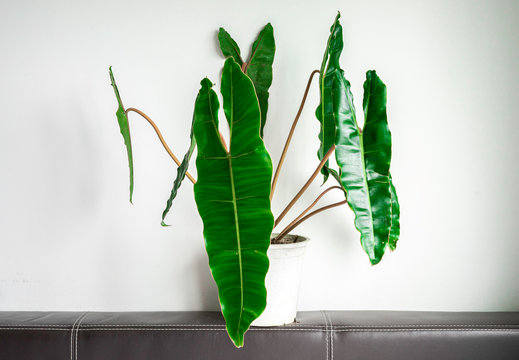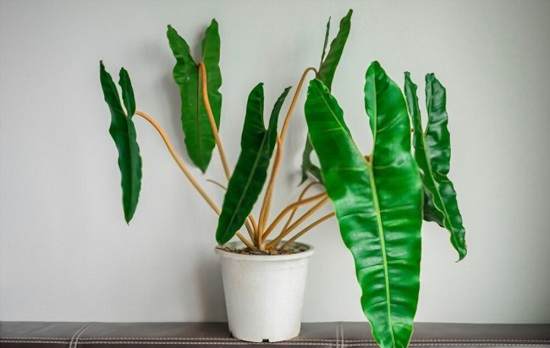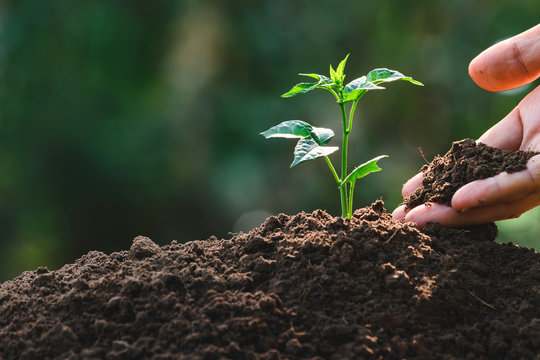Hey! Want to learn about the beautiful Philodendron Billietiae? You are at the right place. This plant is mostly known as Billie and Philidor. It is an everlasting beauty, commonly appreciated for its unique and long leaves and bright orange-colored stalks.
This plant is from the tropical regions of Brazil, Guyana, and French Guiana’s rainforests. Because of this, it must be cared for according to its regional requirements.
Post Contents
- Philodendron Billietiae at a Glance:
- Philodendron Billietiae Size, Characteristics and Growth:
- Philodendron Billietiae Care and Maintenance:
- Light Requirements:
- Watering the Philodendron Billietiae:
- Temperature and Humidity Requirements:
- The Right Kind of Soil:
- Fertilizing:
- Pruning:
- Repotting:
- Propagation:
- Frequently Asked Questions:
- Conclusion:
- Author
Philodendron Billietiae at a Glance:
Get a glance of Philodendron Billietiae, including its name, family, native region, and care overview.
| Information | Description |
|---|---|
| Common Name | Philodendron Billietiae |
| Scientific Name | Philodendron billietiae |
| Family | Araceae |
| Native to | Colombia |
| Growth Habit | Climbing vine |
| Leaf Shape | Heart-shaped with lobes |
| Leaf Color | Dark green with silver veins |
| Light | Bright, indirect light |
| Watering | Allow soil to partially dry between waterings |
| Humidity | Prefers moderate to high humidity |
| Temperature | Average room temperatures (18-24°C) |
Philodendron Billietiae Size, Characteristics and Growth:
The size of leaves of the Billietiae can reach up to three feet in length and eight inches in width. This can only be obtained if the plant is provided with conditions similar to its natural habitat.
The Billietiae is a very popular indoor plant and a common favorite among indoor plant growers and collectors. The quality that provides an interesting display is their leaves.
It looks extraordinary when this plant can climb a pole or fence. The leaves are arrow-shaped and have a color scheme of orange and green.

All the Philodendron varieties are very quick-growing plants. Their normal growing rate under suitable conditions is 4 inches a week during warm seasons like the spring and summer.
Let’s hop into the main part of our article, where you’ll find everything you need to know about the care and maintenance of Philodendron Billietiae.
Related Post: Philodendron Lemon Lime Care Guide (Tips to Grow Perfectly)
Philodendron Billietiae Care and Maintenance:
Below is a guide having all the essentials you probably are looking for. You can keep your plant happy and healthy using the following tips and tricks.
Light Requirements:
Talking about the essential light part, remember that Billietiae doesn’t need any direct sunlight. Light requirement is one of the most crucial point in Philodendron Billietiae care. It would be best if you always placed it in an area that receives bright, indirect light.
Moreover, this will ensure the plant’s light requirements and keep the plant at risk of getting burned. As we know, plants from tropical habitats always stay in the shade and don’t like direct light.
Never leave your plant in direct sun. Doing this will make it scorched, and they will become yellow because of this burn.
If you see direct and bright sunlight coming through your windows, keep your plant a few feet away. Opt for a north-facing or east-facing window. These preventative measures to shield your billietiae from direct sunlight will yield positive results.
Watering the Philodendron Billietiae:
Watering the Billietiae comes with two factors. First, it grows best in moist soil, and second, if the soil is too wet, it could cause root rot. Now, the aim is to keep the soil in a water and moisture level that is not too high or too low.
Never overwater your plant, as this effect is not immediately obvious. Rather have a regular watering routine with less water.

To keep your plant safe from the effects of overwatering. When you water it, check how moist or dry the soil is.
Check by pressing a little bit on the soil. If you feel that the top inch of the soil is dry, you can go ahead and water the plant. If the soil is moist, check back in a few days.
Water your Philodendron thoroughly until you see it coming out through the draining holes. Get rid of the excess water from the soil using a tray. This method helps to keep the soil moist throughout.
Till now, the scenario was over-watering. On the other hand, never neglect to water your Philodendron. We can see that it can stay a while without watering but always remember that it cannot go long periods without water.
Temperature and Humidity Requirements:
This is also essential for the Philodendron Billietiae. Considering this plant’s natural habitat, daytime requirements range between 65 F – 80 F. On the other hand, during the night, the temperature range should stay between 55 F and 65 F.
When the plant is indoors, achieving these temperatures is mostly easy. If you keep your plant outside during warm weather, always remember to bring it inside before it turns cold.
This plant gets affected by cold and frosty weather. It can decline quickly if exposed to cold weather. So avoid temperatures below 55 F.
Concern about the humidity is this plant will thrive in average to high humidity. Usually indoors, controlling the humidity can be difficult. Plus, we know that, naturally, homes are dry.
Increase the humidity by using an inexpensive humidifier, or you can use a tray filled with pebbles and water. Place your plant in it; the humidity will increase a little because of the evaporation process.
Also Read:
The Right Kind of Soil:
Always go for well-draining soil. A soil that can keep your Philodendron’s soil moist but not wet or soggy. Water-clogging soils will lead to root rot problems, which is a big no for this plant.
For this purpose, we recommend getting or mixing soil that contains peat, perlite and vermiculite. You can also enhance your soil by adding organic matter such as compost, increasing the soil’s nutrient levels and helping it become more grainy.

These soil mixes drain fast, but they also keep a lot of moisture to provide enough humidity to keep your Billietiae hydrated.
Fertilizing:
Fertilizing is needed if you want your Billietiae to have lush and vibrant leaves. We recommend going for a slow-release fertilizer with essential nutrients. You can add this to your plant every 2-3 months.
Besides this, you can opt for foliage plant fertilizer. Ensure that it is balanced. If you are using this, you must dilute it to a weak solution. This will only help if you use this every 4-6 weeks.
Always use the fertilizer when the plant grows, in spring and summer. This is because plant growth is very slow during cold weather. If you fertilize it during winter, it will get its roots burned.
Pruning:
This plant doesn’t need much pruning. But if you notice any dead leaves or untidy parts of the plant, you can cut them off. Always use a pair of sharp, sterilized scissors.
Just cut off the parts that seem to be pruned. Otherwise, regular unnatural cutting will lead to slow growth.
Repotting:
Philodendron Billietiae can grow in regular terracotta pots, and you can also grow them in hanging baskets. Repotting can be done every 2-3 years.
Don’t let the plant become rootbound. Repot it before this happens. Because being rootbound can cause stress to the plant and make it prone to several diseases.
Read More: Philodendron Bipennifolium Care & Growing (Expert Guide)
Propagation:
We will recommend the quickest and easiest method of propagating the Philodendron Billietiae. You have to harvest stem cuttings. Pick a stem cutting around 2-4 inches with a few leaves.
Cut the stem below a leaf node and plant it into moist soil, or even water can do the job. Just ensure that the plant is in a warm location and gets the required bright, indirect light.
Frequently Asked Questions:
Is Philodendron Billietiae toxic?
Yes! This plant is toxic to both humans and animals. The toxicity is the calcium oxalate crystals found in all plant parts.
Does Philodendron Billietiae Climb?
Yes! The Philodendron Billietiae plant can climb on tall structures like a pole or bamboo stick.
Is Philodendron Billietiae easy to grow?
Yes! It can be an easy plant to grow only if you ensure it receives the essentials according to its natural needs.
Are Philodendron Billietiae fast growers?
It can be a fast grower if provided with care and all the natural conditions. Plus, it can reach good heights and widths.
Conclusion:
Suppose you want a beautiful plant with leaves shaped like a beautiful heart and elegant stems.
The best choice is the Philodendron Billietiae, an incredible ornamental plant that looks stunning when kept inside. They are easy to grow when cared for well.
We hope you’ll get one of these because the plant care recommendations above will help you grow a healthy Billietiae that can thrive easily indoors.
Related Articles You May Like:

